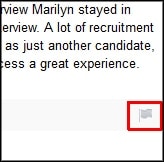
Recently, a WI based business in the senior care market approached The Creative Company after receiving the following one star review on Google:
“I found the manager to be very nice and helpful, but a number of her receptionists are just down right rude. So regardless of how nice the manager seems to be, why would I bring my family to a place where rude behavior is tolerated to the point that it becomes the culture?”
What should the leadership team at this business do?
A: What review? Our business’ word-of-mouth reputation is great so we don’t care much about online reviews.
B: There are so many websites that allow reviews making it hard to keep up. When we see a review, we respond.
C: Immediately respond to the reviewer with a heartfelt apology.
D: Take a deep breath, calmly and patiently investigate the review, and then create a strategy to mitigate its effects.
For those of you who chose answer A, here are the things to consider. As online communities continue to grow and prosper, consumer feedback opportunities online will continue to proliferate. Google reviews are a known search engine ranking factor, especially for searches deemed by Google to have “local intent”, such as a search for “attorney near me” or “burglar alarm for my home.” By doing nothing, you’re accepting the risk that declining search engine rankings will not impact your business’ bottom line over time.
If you answered B, we can empathize. Reviews can be posted on a wide variety of websites, including Google, Bing, Facebook, YELP, etc., as well as industry specific referral sources. It’s tough to stay on top of them all. Fortunately, there are a number of review monitoring tools that can help. If you search for “monitor online reviews” there are many choices. Picking the best tool will depend on the size and scope of your business. These tools are usually priced per month and “by location”— the more locations to monitor, the higher the monthly fee.
The business in this example opted to pursue a blend of answers C and D. Certainly anyone can have a bad day and interact with others in a less than positive manner. After taking that deep breath we investigated the review more closely and immediately grew suspicious. Like many local businesses, this location has no dedicated receptionists on staff. Who are these phantom receptionists that treated this person so rudely? The business also had no records of the reviewer interacting with staff: no phone records, no visits logged, no emails, nothing. Next, we looked into the reviewer. We found that this reviewer had left eight other one-star reviews for being treated with some degree of rudeness (“rudely”, “very rude”, “snippy”, “consistently rude”, and “quite rude and inconsiderate”) at eight locations spread over 267 miles.
 At this point the simplest thing to do was to “flag” the review at Google. While we consider the review highly suspicious, does the review actually violate the letter of Google’s Review Policy? We decided to flag the review and find out. We did this by locating the review at Google and clicking on the little flag icon. This is supposed to trigger a process at Google and then Google would send the results of this process back to the “flagger” (person who triggered the review). What happened? Nothing. The review was still live and no communication was received by the person that flagged the review.
At this point the simplest thing to do was to “flag” the review at Google. While we consider the review highly suspicious, does the review actually violate the letter of Google’s Review Policy? We decided to flag the review and find out. We did this by locating the review at Google and clicking on the little flag icon. This is supposed to trigger a process at Google and then Google would send the results of this process back to the “flagger” (person who triggered the review). What happened? Nothing. The review was still live and no communication was received by the person that flagged the review.
Naturally, frustrations ran high. We decided to try and contact Google directly by using Google’s online chat function at “Google My Business.” At Google, reviews are tied to locations through Google My Business (before contacting Google you must have the email address associated with the Google My Business listing on which the review was placed). During the chat process, we were able to enter details about our suspicions and why we felt the review should be removed.
What happened next? Check back in 30 days to learn the outcome and more about offensive and defensive strategies that your business can implement immediately. Plus, learn more about how reviews fit into Google and Facebook user experiences as they compete for users time and advertising dollars.
